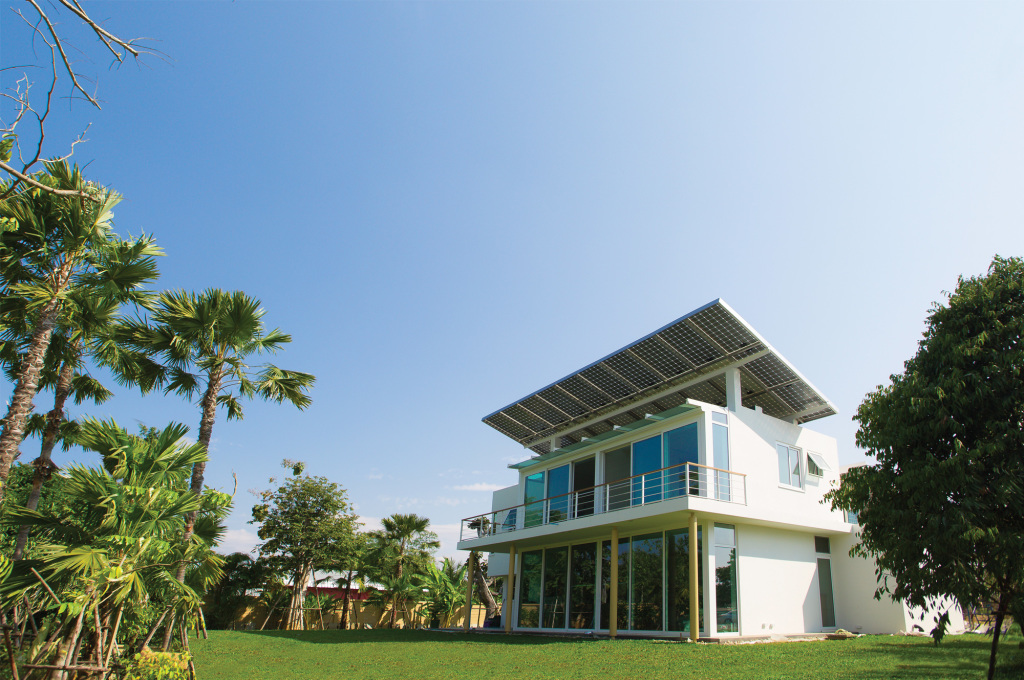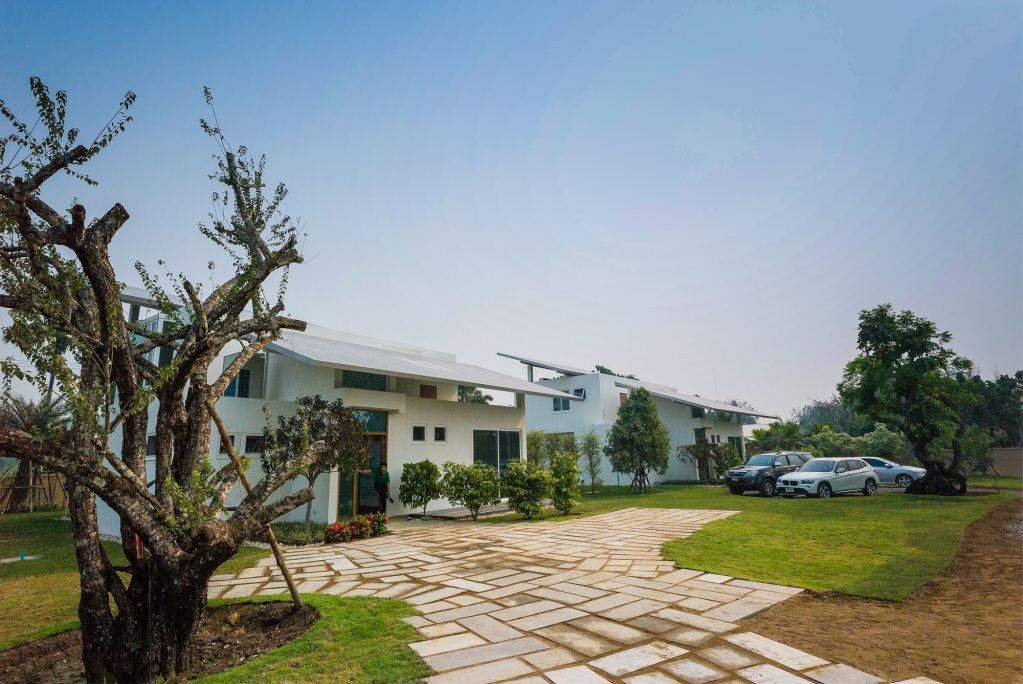“For less than the price of a Ferrari, you can build our system,” proclaims Sebastian-Justus Schmidt, the mastermind behind the world’s first self-recharging renewable energy system for a multi-house compound, Phi Suea House. “I really want to make a point,” he says proudly addressing the group gathered for Phi Suea House’s first media day, “to show how hydrogen energy storage works and to show the way.”

Sebastian chose March 20th as the day to unveil Phase 1 of the Phi Suea House carefully. On this day a total lunar eclipse effected Europe, which Sebastian leveraged as a way to highlight a major problem with the use of solar power – no sun means no energy. The Phi Suea House, however, easily rectifies this issue by creating hydrogen energy storage, something that has never been used domestically before.
On this day three of the buildings are complete and operational. The structures gleam in the sunshine, geometric, minimal structures composed of white walls and large pane glass windows, a large no-nonsense metric of solar grids crowning their tops. Upon completion in late 2015 the Phi Suea House Project will boast four family homes, a pool and beach volleyball court, and a permaculture garden with a large pond.
“It’s a dream to have 24-hour access to the power of the sun. With our renewable power system and hydrogen energy storage, we have fulfilled this dream,” beams Sebastian.
As he stands with members of his family, a green ribbon is cut by Hagen Dirksen, Honorary Consul of the Federal Republic of Germany, to signify that Phi Suea House has officially moved into the testing phase. Sebastian’s son, Jan, gives an enthusiastic thumbs up as the media begin to file curiously into the one-of-a-kind home.
 The Creation Story
The Creation Story
The Schmidts have lived in Chiang Mai now on and off since 2004 when Erika, Sebastian’s wife, and their three kids Jan, Max, and Linnea all fell in love with Chiang Mai. “After three months we returned to Germany. However, my business became more and more successful and I needed to come back to Asia to be close with my customers. This was the moment that we decided to go to Chiang Mai again – this time for a year. It was planned for a year, but we stayed longer and sold our house in the suburb of Hamburg,” recounted Sebastian. The oldest son, Jan, graduated from high school in Chiang Mai and is now a project leader overseeing the energy storage and automation portions of the Phi Suea House. The family works closely together and has made the Phi Suea House uniquely their own.
Sebastian’s experience as the co-founder of a telecommunications firm SPB TV AG in Switzerland spawned the concept of a domestic renewable energy system. His experience in IT, media and telecommunications gave him direct access to renewable power stations many IT companies in remote areas keep in case of a power failure. Seeing these green power stations that require little maintenance and no fossil fuels inspired Sebastian to find a way to make the technology widely available and applicable. Thus the idea for the Phi Suea House was born.
“Some telecommunications sites already use electrolysers and fuel cell systems for backup power, as do a few enthusiastic individuals with experimental installations around the world, but the Phi Suea House is the first multi-house compound worldwide to use a hydrogen energy storage system,” he explains.
The vision of creating a system that can be duplicated for domestic homeowners and the growing concerns of climate change has made the project a very personal one for the Schmidts. “It means a lot to me that we are not just building our house, but that we try to raise awareness for sustainability and renewable energies and hopefully encourage others to apply some of the same technologies in their residential projects,” said Jan.
 The importance of the project and the deeply rooted desire to be good stewards of the environment created very high expectations for potential contractors. Sebastian struggled to find a construction company that could deliver his vision. “We started to discuss building our house with construction companies in Chiang Mai but it turns out that at least the ones we talked to weren’t really cooperative and didn’t provide a feeling of transparency. This was the starting point to form our own team _ which in the end turned out to be a complete construction company where things are done differently,” Sebastian elaborated.
The importance of the project and the deeply rooted desire to be good stewards of the environment created very high expectations for potential contractors. Sebastian struggled to find a construction company that could deliver his vision. “We started to discuss building our house with construction companies in Chiang Mai but it turns out that at least the ones we talked to weren’t really cooperative and didn’t provide a feeling of transparency. This was the starting point to form our own team _ which in the end turned out to be a complete construction company where things are done differently,” Sebastian elaborated.
Thus, CNX Construction was born and along with Sebastian’s son Jan and Karn Nattapong, CNX Construction’s managing director, they set out into unfamiliar territory.
Jan recounted the early days, stating, “Of course there are always challenges that a new company has to handle, but we have a very strong team that is always learning and applying new things. We come up with innovative solutions on our own, but we also know when we need to seek expert help and advice. We speak to local experts in Chiang Mai and all over Thailand, and we also go to leading international exhibitions and conferences.”
CNX Construction meticulously gained a repertoire of skills and slowly but surely the Phi Suea House came together. The resulting compound exhibits an attention to detail both inside and out. Their appearance is unified by a sleek, sterile but homely environment of clean white and subtle hints of natural wood. At the same time, portions of the compound display the science of Phi Suea House proudly. The room that houses the bright primary blue hydrogen storage tanks not unlike a scene out of 2001: A Space Odyssey.
 Tech Time
Tech Time
The green technology of the Phi Suea House is rather simple. During the day solar panels on five of the structures capture energy from the sun and send it to the energy building. The energy building then distributes power to the buildings on the compound while also converting water into hydrogen gas. Hydrogen is stored for later use to power the house at night. The Phi Suea House operates completely independent of any power grid. Sebastian predicts that this method of renewable energy can actually introduce more oxygen into the atmosphere instead of consuming it, arriving at a state he classifies as “carbon negative.”
“Using only renewable electricity and having the energy storage emit small amounts of oxygen as a by-product will massively help us become carbon negative very soon,” says Sebastian.
This efficiency expands beyond the use of solar power and hydrogen storage, however. Energy conservation has been the core requirement for every designed element and material used in the construction of the house.
“Using better materials for isolation, like double glazing, reduces the need for electric power and will help reduce the carbon footprint. Designing the house to stay naturally cold through isolation and airflow also means that you will reduce the carbon calculation,” describes Sebastian.
The technology used with Phi Suea House is also meant to be compatible with other homebuilders that wish to implement it. “This unique setup’s central energy system for multiple houses is the reason that the hydrogen energy storage is also financially viable on a household-by-household level,” elaborated Sebastian.
Trials and Tribulations
To the laymen, hydrogen might be a scary word. Using the gas to power a home definitely raises some eyebrows due its notorious combustibility. However, Jan insists that it is not dangerous.
“Hydrogen gas storage is very simple and safe, however it is necessary to ensure the space is well ventilated and any leaked gas can easily escape at the top of the room. There is virtually no risk of explosion even from a spark or flame, because any gas that is released rises extremely quickly and there is no possibility of build-up of gas in a trapped space.”
While the project has been delayed at times and unforeseen obstacles have arisen, the Phi Suea House is ahead of schedule. The new completion date is set for the end of 2015 and from start to finish would put the build at 2 years.
A Call to Action
No innovation is without its struggle, and the team still has a lot of work to do, but there is much reason to celebrate. The Phi Suea House is a start to what Sebastian believes will be a global movement, “We are sure that further improvements in electrolyser and fuel cell technologies and the expected price drop from mass-productions will allow for hydrogen energy storages to become widely used all over the world.”
Sebastian is an innovator and a man who believes in challenging the status quo. The Phi Suea House is not merely a renewable energy house, but a real world example of progress. In Chiang Mai especially the effects of emissions are all too obvious, our production of pollutants around the world has reached a critical point. Developments like the technology used in the Phi Suea House is more than tinkering with convoluted science that will never see the light of day, it is a sincere attempt at solving a problem.
While it is a strong step in the right direction, the cost of a Ferrari is still prohibitive to most. It is people like the Schmidts, who are willing to invest in the future, who will one day help our Toyotaesque budgets stretch into the ownership of a carbon negative home.
For more information check out cnxconstruction.com.

